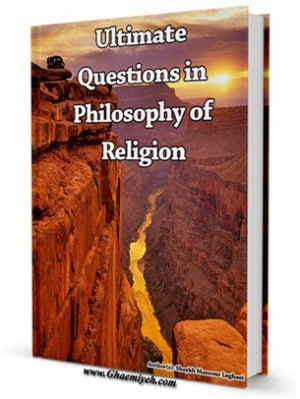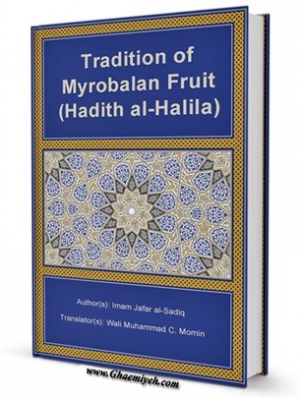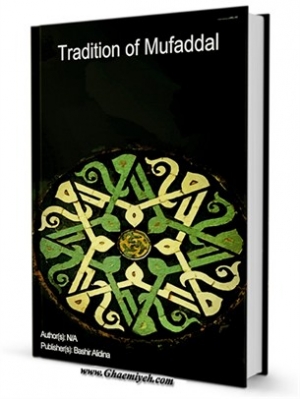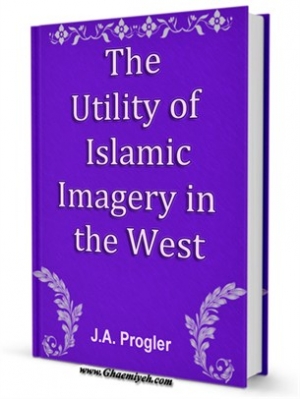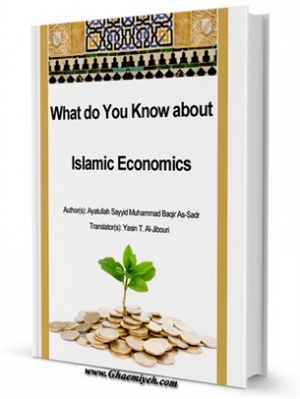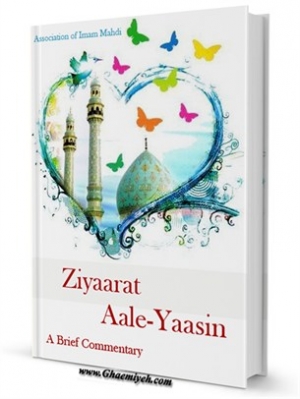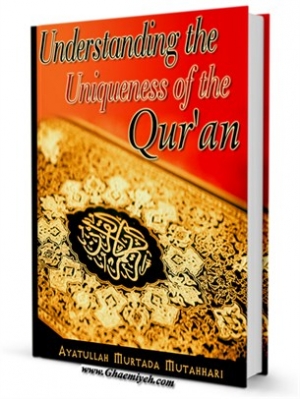Super User
Brief introduction
This book is written by Shaykh Mansour Leghaei. In this book the author delves into the philosophy behind several intrinsic faith matters such as belief in God, free-will or predeterminism, the question of evil and much more.
Dr Sheikh Mansour Leghaei (born 1962) is the founder and a director of the Imam Husain Islamic Centre and the School of Islamic Theology in Earlwood, Australia, serving as the imam from 1997–2010. He previously served in Nigeria, where in 1992 he opened an Education Centre called Ahul Bayt.
Leghaei is seen as a prominent member within the interfaith communities and was the chairman of the Marrickville Interfaith Round Table. Leghaei has attended a number of seminars to provide an Islamic perspective, including the Ecumenical Service on the Dead Sea Scrolls held at the Sydney Art Gallery, "Religious Therapy" on the occasion of World Cancer Day at the University of Sydney and "Spirituality of Great Traditions" at St. James' Church.
Brief introduction
This booklet contains a thought provoking dialogue between Imam Ja'far al-Sadiq (a) and an atheist physician from India. Using logical arguments and the Myrobalan fruit as its theme the Imam convinces the atheist beyond doubt of the existence and attributes of Almighty Allah. This tradition is recorded by Allamah Majlisi in Bihar al Anwar vol 3 pages 153-196 and translated by Wali Muhammad C. Momin and then published by Majlisul Muslemeen.
Says Qur’an:
Allah affirms that there is no god but He; and so do the angels, and those with knowledge, He is established in justice. (3: 19)
Such is the claim of the Qur’an. So when we come across the atheistic people or those who seriously believe in the Theory of Evolution and deny the existence of any Creator of this Universe and its paraphernalia we attribute it to their lack of knowledge either inherent or acquired.
Again, says Qur’an:
“Your God is one God.” (16: 7),
“Allah-there is no deity but He, Living the Eternal.” (2: 257)
This is the assertion of the last Book of Allah revealed to Muhammad (S). But for an explanation of the verses of the Qur’an we must refer either to Muhammad (S) himself to whom it was revealed or to those about whom he did direct us to refer to.
Said Muhammad (S): I am the City of knowledge and ‘Ali is the gate of it.
After ‘Ali (A) we have a chain of his children and grand children towards whom we must look for inspiration and guidance in all our affairs.
Now in an age when people have either denied the very existence of One God or have lost faith in His attributes such as Omnipotence, Omniscience etc., we present a conversation that took place in the 2nd century of Islamic era between Hazrat Imam Ja’far al-As-Sadiq {A), the sixth in the series of the twelve Imams of the House of Muhammad (S), and a philosopher-cum-physician from India who was a staunch votary of atheism.
Needless to say that the intellectual caliber of the Imam was highest in that age as he had his knowledge from Allah. What needs our close attention is the fact that nearly 1200 years ago the mind of a man like us could argue so forcefully that not many intellectual giants that survived during this long period could have attained that standard.
However the counter arguments of the Imam (A) convinced the atheist about the Existence of Allah, His Oneness and other attributes so much so that he embraced Islam.
Brief introduction
This is a book written by Sherif Muhammad Abdel Azeem, published by World Islamic Network. It argues about the comparision of the position of women in Islam, Christianity Judaism based on the Qur'an, Bible Talmud respectively.
Contents in brief
The author compares the attitudes of the three religions in different subjects such as Eve's fault, Eve's legacy, shameful daughters, female education, unclean impure woman, bearing witness, adultery, vowes, wife's property, divorce, mothers, plight of widows, polygamy, the veil.
You read one part in the following:
The three religions agree on one basic fact: Both women and men are created by God, The Creator of the whole universe.
However, disagreement starts soon after the creation of the first man, Adam, and the first woman, Eve. The Judaeo-Christian conception of the creation of Adam and Eve is narrated in detail in Genesis. (2:4-24)
God prohibited both of them from eating the fruits of the forbidden tree. The serpent seduced Eve to eat from it and Eve, in turn, seduced Adam to eat with her.
When God rebuked Adam for what he did, he put all the blame on Eve,
"The woman you put here with me -- she gave me some fruit from the tree and I ate it." (Genesis, 3: 12)
Consequently, God said to Eve:
"I will greatly increase your pains in childbearing; with pain you will give birth to children. Your desire will be for your husband and he will rule over you." (Genesis, 3: 16)
To Adam He said:
"Because you listened to your wife and ate from the tree of which I forbidden you to eat, “Cursed is the ground because of you; through painful toil you will eat of it all the days of your life..." (Genesis, 3: 17)
The Islamic conception of the first creation is found in several places in the Qur’an, for example:
"O Adam! Dwell with your wife in the Garden and enjoy as you wish but approach not this tree or you run into harm and transgression. Then Satan whispered to them in order to reveal to them their shame that was hidden from them and he said: 'Your Lord only forbade you this tree lest you become angels or such beings as live forever.'
And he swore to them both that he was their sincere adviser. So by deceit he brought them to their fall: when they tasted the tree their shame became manifest to them and they began to sew together the leaves of the Garden over their bodies.
And their Lord called unto them: 'Did I not forbid you that tree and tell you that Satan was your avowed enemy?' They said: 'Our Lord we have wronged our own souls and if You forgive us not and bestow not upon us Your Mercy, we shall certainly be lost.'"(7:19-23)
A careful look into the two accounts of the story of the Creation reveals some essential differences.
The Qur’an, contrary to the Bible, places equal blame on both Adam and Eve for their mistake. Nowhere in the Qur’an can one find even the slightest hint that Eve tempted Adam to eat from the tree or even that she had eaten before him. Eve in the Qur’an is no temptress, no seducer, and no deceiver. Moreover, Eve is not to be blamed for the pains of childbearing. God, according to the Qur’an, punishes no onefor another's faults. Both Adam and Eve committed a sin and then asked God for forgiveness and He forgave them both.
Brief introduction
Pearls of Wisdom from Imam Ja'far al-Sadiq (`a)This text is the English translation of the Tradition of Mufaddal, as narrated by his companion Mufaddal ibn `Umar. Recorded by by 'Allamah Majlisi (d. 1110 AH) in Bihar al-'Anwar, volume 3, page 57, chapter (bab) 4, tradition (riwayah) no. 29. It describes the amazing ingenuity the Almighty manifested in the universe, human beings, the animal kingdom, nature and natural disasters. Published by Bashir Alidina.
Contents in brief
First session: Imam Sadegh (A.S) in the first session states that the reason of denying and doubting in existence of Allah is ignorance towards the causes of the creation. Afterwards argues about this fact that how the whole world was created? The creation of human beings and all his organs like digestive system and five senses and talks about the discipline and harmonies between human and Allah.
Second session: in this session Imam (A.S) points to some existed secrets in animals. He mentions some secrets about reptiles such as snakes, quadrupeds like elephant, giraffe, monkey and dog and birds like chicken and bat and insects like bee, locust and ant and various fishes.
Third session: Imam points out some secrets about the creation of sky and earth. He talks about the color, sunset, sunrise of the sun and seasons of the year and month and other stars.
Fourth session: in the last session Imam argues issues like the reason of disasters, problems, death and perdition. He talks about the reality of death and life, the reason of human creation, and the way of understanding the world and mentioning the difference of sense and wisdom in cognition of the world and its facts.
Brief introduction
This book is written by J.A. Progler (Asst. Professor of Social Studies at CUNY, Brooklyn College) and published by al-Tawhid Islamic Journal. It is a discussion of the negative imagery of Islam in the West. The Orient and Orientalism, Medieval Phantasms of Sex and Violence, Holy War, and The Utility of "Muslim Terror" in Israeli-American Relations are some of the book's main subjects.
Contents in brief
The long history of encounters between Western civilization and Islam has produced a tradition of portraying, in largely negative and self-serving ways, the Islamic religion and Muslim cultures. There is a lot of literature cataloguing (and sometimes correcting) these stereotypes. It is not my intention to rehash this corpus here, though I do rely upon some of the more important works.
What I want to do instead is focus on a particular dimension of these encounters, and examine why the West has consistently constructed and perpetuated negative images of Islam and Muslims. My focus will be on the utility of Islamic imagery in Western civilization.
Most people seem to be familiar with stereotypes and negative imagery of Arabs and Muslims-indeed, some are so firmly entrenched that the consumers of these images are unable to distinguish them from reality. At the same time, many people have an idea how these images come about (books, television, speeches). But by looking at the cultural history of Islamic-Western encounters from the perspective of utility, I am able to locate the correlations between imagery and political economy.
Western image-makers, including religious authorities, political establishments, and corporate-media conglomerates, conceptualize for their consumers’ images of Muslims and/or Arabs in sometimes amusing and other tunes cruel or tragic ways. Upon closer examination, these images seem to serve essential purposes throughout the history of Western civilization.
At times these purposes are benign, at others quite sinister. Often, there are tragic consequences for Muslims resulting from the socio-political climate fostered by images. Focusing on the dimension of utility can help to reveal some ties between imagery and action.
At the same time, I am aware that focusing solely on imagery misses the important dimensions of intention and power. Though I reserve a careful look at these dimensions for another study, I do recognize the need to consider here some of those people who have the power to provide public conceptualizations of Muslims, such as religious figures, academics, policy pundits, journalists, and entertainment conglomerates.
Drawing upon the historical and cultural catalogue of assumptions and perceptions about Islam, these experts and spokespeople pick and choose the appropriate images to serve their purposes. Many times, they are seemingly unaware of using an image, which is indicative of how deeply entrenched they have become. The stories of those with the power to present need to be told, but they are beyond the scope of this article.
Similarly, fruitful research may also reveal the degree to which Muslims contribute to their own images. That, too, I will reserve for another study. The purpose here, then, is to suggest some of the broader utilitarian dimensions of Islamic imagery in the West.
A recurring theme in the present study is the idea of packaging the complexities of Islam and Muslim cultures into easily comprehensible categories-good and bad, beautiful and dangerous, desirable and repulsive-and I look at these in terms of their utility in Western cultural history and political economy.
Academic culture is an important site to reveal the utility of imagery, since these are the studies that inform policy makers and politicians; this is also where Western ideas are introduced into native cultures. But it is also necessary to focus on popular culture, especially news and entertainment, because this is where many people in the West get their impressions of Islam and Muslims.
Brief introduction
This book is written by Ayatullah Sayyid Muhammad Baqir As-Sadr and translated by Yasin T. Al-Jibouri. It is a short text about the nature of the Islamic economic system, its distinction from Capitalism and Marxism, and the primary obstacles encountered in its application to society today.
Contents in brief
People have increasingly been, for quite some time, demanding to get the series of “The Islamic School” out, and the dear readers have been insisting that I must issue a new series for them.
I have been reluctant to respond to such requests due to my desire to focus my efforts on finishing the second volume of Iqtisaduna (“Our Islamic Economics”). The publication of this latter book has been the reason behind the increasing demand that I should issue a brief series explaining and simplifying the book’s researches so that they may become accessible and comprehensible by a larger number of readers.
On this basis, I have written this series, taking special pains to make it simple, avoiding the level of precision and depth which I retained while researching “Our Economics.” On numerous occasions, I have preferred to explain an idea rather than describing its precise form, since the latter is already available in our detailed books.
While introducing this series to its readers, I shall first try to summarize its ideas for them and provide them with a table of contents which ought to help them comprehend it and follow its chapters.
This series includes raising one question and the attempt to answer it. The question is: “Does an economic doctrine exist in Islam?”
In this series, we shall gradually answer this question in the affirmative. After we raise the question, we will be busy explaining it and everything relevant to it. After that, we shall study the answer in the light of our comprehension of Islam, supporting it with proofs and discussing any objections to it.
Brief introduction
A brief explanation of the Ziyaarat al-Aale Yaasin, the profound and meaningful salutation from Imam al-Mahdi (a.t.f.s.). Published by the Association of Imam Mahdi in Shaabaan 1425 A.H.(2004)
Contents in brief
The word "زیارات" is an Arabic term derived from the root "زوَرَ" which means ‘to visit’. In religious terminology, it implies our conversation with Allah’s sincere creatures and His infallible proofs (a.s.), who are without parallel. They are those whom Allah, the High, has purified from all uncleanness and has created them pure, purified.
Thus, whosoever desires to approach Allah, he should do so through the gates determined by Him. Yes, the infallible Imams (a.s.) from the immaculate Ahlul Bayt (a.s.) are the gates through whom Allah is approached. They are the medium towards Him and hence, their recognition, their love and treading on their path is obligatory. All these are summarized in one thing i.e. ziyaarat.
It is our creed that the souls of the holy Ahlul Bayt (a.s.) ascend towards the highest heavens and are alive, receiving their sustenance (from their Lord). They look at us, hear our speech and reply to our salutations. As Ameerul Momineen (a.s.) narrates from the Holy Prophet (S),
“Those who die among us, are not (actually) dead.”
The belief of us Shias is contrary to that of the Wahhaabis who think that the Holy Prophet (S) is dead and gone and is no longer effective in our lives. We are also against the (غلات) who attribute divinity to Ameerul Momineen (a.s.)! Allah is Higher than what the unjust believe!
We subscribe to the belief that Holy Prophet but the most superior of them all. He is followed by his successors, the Holy Imams (a.s.). In our time today, Imam Mahdi (a.t.f.s.), the Promised One, is his successor.
So from among the etiquette of ziyaarat is that the one whose ziyaarat we are about to read, his recognition is a must. It is not possible for us to acquire the recognition of the Holy Prophet (S) or the infallible Imams (a.s.) through the faulty or inadequate faculties available to us humans. Just as an ant, in front of a huge mountain or a drop of water when compared to an ocean, are not worth a mention, we too when compared to these great personalities, are even more insignificant and miniscule than the ant or the drop of water. Then how is it possible that we describe or recognize them? Since only Allah the Almighty possesses their all-encompassing recognition, the only method to recognize them is through revelation. If we acquire any other mode of recognition, then indeed we will be among the seventy-two doomed sects.
Then what is the solution? Now, the only way is to describe the sun from the characteristics of its tongue, the ocean from its reflection in the mirror and the height of a mountain from the bird that flies over its top. Therefore, we should acquire the beliefs from these infallible and holy Imams (a.s.) so that we neither become like the Wahhabis nor become like the exaggerators (غلات).
We also believe that,
‘By his (a.t.f.s.) blessing are the creatures sustained and through his existence, the earth and the heavens are firmly established.’
We being among his flock and his guests must necessarily greet him every morning with our salutations. We must offer our greetings as taught unto us by the Ahlul Bayt (a.s.) and renew our allegiance with him (a.t.f.s.). We should seek from Allah the Almighty with a blazing heart that He hastens his noble reappearance. This is what he (a.t.f.s.) has ordered us to do when he says,
‘And pray most for the hastening of the reappearance, for certainly, it is your salvation.’
Since last many years, Association of Imam Mahdi (a.t.f.s.) has had the practice of introducing one supplication or ziyaarat of the infallible Ahlul Bayt (a.s.) in the special issues of Al-Qaem al- Muntazar (a.s.). Approximately three years ago, we undertook the task of a brief explanation of the Ziyaarat al-Aale Yaasin, the profound and meaningful salutation from Imam al-Mahdi (a.t.f.s.). Due to constraints of space, the explanation could not be published in one issue and as a result, had to be spread over three special issues of Shabaan al-Muazzam over a span of three years.
Therefore, we decided to publish the entire explanation in a booklet for the benefit of our readers, of course, with minor changes and variations.
We request our respected readers to provide us with their valuable and constructive suggestions to improve upon our efforts in the future. We hope the Almighty Allah, for the sake of His Hujjat (a.t.f.s.), accepts this humble offering.
Finally, before starting to recite the Ziyaarat and its explanation, we go to our master, Imam al-Zamaana (a.t.f.s.) and plead with him,
Master! The tears of the oppressed are waiting for someone to wipe their tears and console them.
Master! The wounded, the amputated and the injured, victims of the atrocities of the modern superpowers, have lost all faith except in the miraculous touch of Yusuf al-Zahra!
Master! The stifled cries of the orphans, the dry eyes of the widows and the bleeding hearts of the scholars, have only one hope. You.
Master! The poor and the destitute lie hungry, sick and diseased. They don’t expect any solace, comfort and relief from anybody except the son of Fatemah (s.a.).
Master! Now even the sacred shrines of Karbala and Najaf, the shrines of your noble ancestors, are unsafe from the filthy designs of the present day Pharaohs!
O Allah! Hasten the reappearance of our master, Imam Mahdi
(a.t.f.s.) and enlist us amongst his companions and helpers!
Introduction to Ghm format:
Ghm is a proprietary format designed by Ghaemiyeh Research Center Isfahan to be used by Gh-Book application in different operation systems: 1- Android 2- IOS 3- Windows Phone.
How to use Ghm format in Gh-boook application:
After downloading the Ghm-formatted file, save it in the memory of your phone or tablet and click on Ghm file. The application detects the file and displays the description and picture of the book. To add the book into your Gh-Book library you can click on “Install” button.
Note:
If Gh-Book application is not installed on phone, tablet, or laptop, Ghm files are not detected.
Ghm Format Features:
Ease of use
> The texts of the book are coded to solve the issue of Publishers and authors
> There are clear, useful, and non-editable contents
> Fast access to the free and payable books
> High speed of Ghm format
> Having the book on side memory and install it again
> Access to books in different languages
> Access to more than 15000 booksGh-Book Application Features:
Application is in 3 different languages: Persian, English, Arabic
> Application operates in 3 Operation Systems: Android, IOS, Windows Phone
> Graphical display of books and all books are categorized in the main menu
> List of last read books in the main menu
> List of “My Books” which contains the latest downloaded books
> List of “Most Popular Books” displays the most downloaded books
> Downloading the books directly from Ghaemiyeh website
> Access to the list of books offline and downloading them when connected to internet.
> To give comment and rank books
> Search in the list of “My Books” and library based on Topic, Autor, translator, publisher, latest books, and the language of books
> Fast search in the text of the downloaded books
> Table of Contents for books
> The ability of editing font, size of text, margins, line spacing, Coloring the diacritics and justifying text
> Displaying Simple and elegant pages of the book and beautiful animations while changing the pages.
> Online registration and sending message in application
> To create a user account, buying books and credit your account.
> To send, share and edit texts of a part of books
> Display the Tables of Contents and fast search among the books
> To create highlights and bookmarks and managing them
> Create toolbar to refer quickly to the pages of the book.
> Different views of screen: Horizontal, Vertical and automatic
> Three different study mode: Night mode, Day mode and Sepia mode.
> Managing the downloaded and upgrading them while connected to the Internet.
> To add and share the files of books to the applications’s directory on device via memory card with prefix of “ghm”
> To remind the user about the upgraded books and to upgrade them automatically
> To add books to transfer them to the application's directory on the device.
> Bulletin boards to inform users
> Different settings in the app
> To support pictures among texts along with audio
> To Comment and taking notes of the texts and managing them
> Support FootNote
> Comprehensive Guide (Help) to familiarize you with the application in 3 different language: Persian, Arabic and English
Designed features for future editions:
> Online search in books:
search in all Ghaemiyeh digital books without limitation to downloaded books.
> Ability to change the text color and background.
> support text books and audio along with text.
> The possibility of wiki texts to each other
Hardware and software requirements
Prerequisite: It does not have
Disk space: 10 Mb after the initial installation
Temporary Memory: At least 30 Mb
Introduction to epub format
It is an open standard for e-books which have been created by the International Digital Publishing Association (Wikipedia). This format is used to create e-books, magazines, and newspapers. The main difference between epub format and Doc is that e-books with the format of epub has the ability of better optimization for smartphones (android phones, Apple and windows mobile), tablets and PCs. One of the amazing features is the ability of reading e-books and having access to millions of books in different languages in different websites. Also, there are huge number of software to read these books with different formats which some of them are mentioned below:
PalmOS
WebOS
Windows
Windows Mobile
Linux
MacOS X
iPhone and iPad
Android
BlackBerry
Symbian OS
Cell phones
Nintendo DS
Sony PSP
Web based reading
And …
Also, there are lots of software to create these books.
However, to use this facility is limited for Persian spoken people. That is, Persian books in the format of this book readers are extremely rare or it is almost unavailable. Only limited number of books exist in this format which are created by authors who resides in other countries or those who didn’t have publication license and usually those Novels which do not contain interesting content.
These book readers usually do not support Persian, Arabic or other letters apart from Latin. Recently, the latest version of IOS can support Persian and Arabic and only with the latest version of Mac the Persian books could be read. However, there are several book reader software which read Persian and Arabic books for Android, windows mobile and Nokia. However, finding Persian and Arabic books is as hard as finding book reader software. Therefore, Ghaemiyeh research center has solved this main issue, with 24 hours of researching, and provided more than 15000 books in Persian, Arabic and English for those who need Islamic Science Education so that everyone in the world can use these books. We also promise to our user that we will provide Islamic Science Books in different live languages in the world.
Book Reader Software for epub format
There are lots of book reader for android such as Laputa, Moon Reader, Arabic & Hebrew and special edition. Moon Reader is the best tested application for reading books in epub format which has an attractive environment and supports more different formats. The latest edition of this application is specially for reading Arabic books which supports Persian better that other book readers.
It also contain turning animation and by scrolling up and down on the left side of the page you can adjust the screen brightness. You can change the font and choose different fonts. I also read English books with audio. Other features are, sharing, comprehensive searching tool, noting, dictionary, translation, transcript, book shelve, reading and downloading books from the network, Automatic scrolling with adjustable speed and other 100 special settings.
Laputa has a more beautiful appearance. Turning pages has animation (like iBook) and it categorizes the books in the shelve. However, it only read the books which are downloaded by the phone and it shows Persian texts from left to right.
Here is the website which explained all the software for epub format for different platforms.
http://wiki.mobileread.com/wiki/E-book_software
Link of downloading of epub formats in your operation system from network library of Application “moonreader pro”
http://www.ghaemiyeh.com/epub.htm
Add this address to the network library of moonreader pro and use from the library of its network.
Below, there are the link of some of epub reader.
Android:
moonreader pro
aldiko
arabcreader
ereader
haihaisoft
Java:
AlbiteReaderTiny
Samsung:
AlbiteReader
Nokia
AlbiteReaderHD-2.2 (N8-00,E7-00,X6-00,C7-00,C6-00,C5-03,5800 XpressMusic,5530 XpressMusic,Nokia 5250,Nokia 5230 Nuron,Nokia N97)
AlbiteReaderNoTouch (X5-01,E5-00,C5-00,N96,N95,N91,N85,N80,E72,E61,E50,6760 slide,6720 Classic,6710 Navigator,6220 Classic,6124 Classic,6120,5730 XpressMusic,5700 XpressMusic,5630 XpressMusic,5500 Sport,5320 XpressMusic,3250,Sony Ericsson J105i)
AlbiteReaderLight (Nokia 3720 Classic,Nokia 5130 XpressMusic)
Sony Ericson
AlbiteReaderNoTouch
Symbian
Dorian
IOS
IBOOK
Windows
Haihaisoft_Epub_Reader
MSReaderPPC
MSReader
Readerv25setup
Linux
fbreader_0.99.0-1_amd64
fbreader_0.99.0-1_i386
fbreader-sources
FireFox
http://www.epubread.com/en
how can you use the electronic files with the format of ePub in your browser?
To read the files with ePub format you should have smartphone, tablet or electronic book reader. Because it is not possible to read these files directly from computer like PDF. Or you should use the special software for this format. Moreover, you can use the browser to read the files as explained below:
You can use FireFox or Chrome (if you don’t have these browsers, you can download). Thus, install the special Add-ons to your browser as shown below:
FireFox: EPUBReader
Chrome: MagicScroll
Overview to EPUBReader Add-On:
After you install this add-on a new icon will appear on top right side of the window. By clicking on this icon, a new page is opened that you can view the books in ePub formats.
If you want to download a book in ePub format from the website “www.ghaemiyeh.com” , the Add-On EPUBReader will load it automatically. After the download is finished, by clicking on the downloaded file the file is shown in a new tab like PDF files.
Overview to MagicScroll Add-On:
After installing the MagicScroll Add-On, you can go to address Magicscroll.net to see the epub e-books. After you access to this website you can create a library for yourself and add different books. You can do this by clicking on “Add a book to your library”.
After clicking on this option a new window is opened which requests the file of the book or the link of ePub book. If you have the file on your system you need to upload it here. And if you have the link of the file you can use the field of “ePub Address”.
After uploading, the file will be added to your library and by clicking on that you can start reading.
MagicScroll is a suitable Add-On with special features designed for ePub files.
Therefore, by using these two ways you can read all the ePub files withouht having smartphones, tablets or electronic book reader. Also, you don’t need to install special application for reading these files and you can use your browser to read them.
Link of EPUBReader for FireFox: www.epubread.com/en
Link of MagicScroll for Chrome: www.google.com/intl/en/chrome/browser
Note:
Google has announced that all users can download more than one million books in ePub format. However, google previously has given this archive to companies such as Sony, Barnes and Noble. However, until now, users were unable to download the ePub files for free. Moreover, google will create the PDF file of these books for downloading. Thus, those users who use eReader, will find the new ePub more helpful.
If you don’t have the hardwear of eReader and you want to read ePub files, you can install “Stanza” or “Desktop reader”
EPUB: is the only standard International Digital Publishing Forum to regularize all e-Books.
EPUB is a Free standardized format that almost all hardware eReader or desktop reader understand it.
“Amazon Kindle” is not able to read the ePub texts without using other softwares to make it readable for Kindle.
While there are other formats, ePub become a standard format for e-Books. Some sellers such as “Sony”, covers these books under a DRM (Digital rights management). However, others will let the books completely open without this kind of cover. ePub files from google books are not under the DRM cover.
It is important to take a note that ePub files are created by an Optical Character Recognition (OCR) System and they are not edited afterwards. However, this software is developed well.
Introduction to jar format:
Java is a programming language created by one of the engineers from the Sun Company called “James Gosling”. James has created JAVA for personal usage apart from C++. Similarly, Linux Torvalds has created Linux for his own usage.
James, first called this program Oak. At that time SUN COMPANY didn’t continue to develop the Oak. However, as the Internet was developing fast and by considering, some features functionality of the program and compatibility with Internet needs, they decided to activate the Oak project and called it JAVA.
The name “JAVA” is obtained from “Jsut Another Vague Acronym”, because all of the writers of this language were interested in Coffee. This, could be seen in Java Logo as well.
The first version of JAVA was written in 1995 and in 1997 the version 1.1 and subsequently version 2.1 were released afterwards. However, until now different versions with different features was released into the market. JAVA is the mother language for “Solaris” operation system. Similarly, “Basic” for Windows and “C” for Unix.
The most important features of Java are that you can use frequently the pre-written codes. Other features are that it is used on different systems. For example, if you have write a program with intel, you can easily use it in Macintosh and Unix. This feature is the key of success for Java.
Simplicity, portability, high performance, robustness, dynamics, and high safety are other features of Java.
The Usual programs which are written by Java are “Applet”. Applet is a dynamic program that runs on a web page and to view that a browser that supports Java needed. Additionally, you can write multi-purpose, high -level applications such as Service Network or Mail server softwares.
Installing Java files
Java applications are usually with the suffix of “jar” or “jad”. Installation of these applications are as same as applications with the format of “sis”
However, sometime the format of these files is changed or, for example, it is changed manually to “Zip” file. If you open these file, usually there are several other files with the format of “Class”. If your file does not have these 2 formats, you can manually change the format by choosing “Rename” option.
To be mentioned, if the App “PC-Suite” or similar application is not installed on your PC you will see this file with the Zip icon. However, it is a file with the format of jar or jad. Anyhow, if you are sure you have the file in java format move the file to your smartphone. Find the file in your phone and click on the file to install it.
Introduction to Html Format
HTML is the abbreviation of “Hyper Text Markup Language”. A HTML file is a text formed of “markup tag”. The “Browsers” realize that how they can show the screen with “Markup Tags”.
> A html file should have the suffix “html” or “htm”.
> Html file is a text which could be created by any simple editors.
> The main functionality of HTML’s tags (Markup Tags) is that how to show the information,
The difference between Suffix “html” and “htm”:
Webpages are usually the files with the suffix of “htm” and “html”. But what is the web?
the simplest definition of “web” is: the connected pages on internet are called web. These pages contain texts, picture, video, audio etc.
These pages use the “links” which is usually a highlighted text to that part of the text has different graphic. By moving your mouse pointer on that part the color is changed and by clicking on it you will be directed to a new page.
Familiarizing with these 2 Formats:
The international web language is (HTML) “Hyper Text Markup Language”. Web pages are designed based on HTML format. The most important features of HTML are listed below:
1- It uses the Hyperlinks
2- Ability to use different styles of lettering using frames
3- To create different tables and text which are designed before
4- To insert graphical pictures in HTML as hyperlink
5- To create form for the user to fill up
But what is the difference between these 2 suffix?
In fact, there are not any main differences between these 2. The only difference is in letter “L” which you can see in “HTML” not in “HTM”. This difference refers to the time that “htm” was initiated when DOS and Windows 3.0 was the operation system. DOS would accept the 8 characters for the name of a file and only 3 characters for a suffix. Other servers specially “UNIIX” to make all the filles adaptable for those who uses DOS, decided to make the suffix of hypertext to 3 character “htm”. However there is not any other difference.
The things you need to know before learning about “HTML”.
To work with HTML you need the things which are listed below
You need a text editor. In windows you can use Notepad. You also can use other text editor applications, however, some software such as “WordPad”, “Microsoft Office Word” and other similar Apps are not suitable for writing HTML Codes, because while saving the text these applications will add some codes to them.
You can find “NotePad” in Start in “Accessories” or using “Run” command by typing “notepad” in the box “Open” and clicking Enter.
You also need a browser such as “Microsoft Internet Explorer” which is install along with Windows or Mozilla Firefox, Opera and other browsers which are usually free to download.
Its better to test the pages you have written in different browsers. Because there are some parts in HTML which are specifically for one browser and is not usable for other browsers.
For using HTML you don’t need to be connected to the internet. You only need to use a browser in your computer.
To save the notepad file click on “Save As” from “File” menu and choose a directory. Type the name of the file with the suffix of “html” in the box “File Name” and click on Save.
Note:
You can use the books in HTML in different applications such as “Word” and…
Introduction to PDF Format:
PDF is a format used for e-Books and compared to other formats like “Doc” is better, because when moving it from a PC to another one the order of the text is not changed. Thus, most of people prefer to transfer files in PDF because, the application to read that file might not be installed on their computer.
How to read PDF
To read PDF file we need to use “Adobe Acrobat Reader”. You can download this app from this website: www.Adobe.com/acrobat
To download a PDF file instead of clicking on file, its better to right click on that and choose the option “Save Target As” to save the file on the PC and easily open the file.
Special Features:
The books in PDF format contains Table of Contents, Table of Contents based on the page Numbers, inserting footer and showing the footers in the text by the in blue color, Search tool in the text, real page numbering, Copy texts and …
Introduction to apk (Android) format
Android is an operation system for smartphones and tablets which supports more than 30 famous companies. Android is an open server that programmers can create different applications for this Operating System using Android SDK . In fact, Android provides a platform for the App Developers to create better applications to use best of smartphone. Android means “Open”, which is a programmer could get the best use of a smartphone. Android lets the programmers to use some functions of the smartphone such as camera, Sending SMS, dialing and… so that they can create powerful and useful applications.
How to Use:
After downloading APK format add it to smartphone, Tablet and Computer memory and click on the file after installing the file. Then, click on the icon which is installed and read the book.
Note:
This is the Java format converted to Android and it is usable for Android below version 2 and if your Android version is higher you need to use the newest formats.
Software Features:
> This application based on Android operating system supports the languages: Persian, Arabic and English.
> Graphical display of Books in the main menu
> Direct download of the digital library of Ghaemiyeh on the device.
> Comprehensive and fast search in the downloaded books and search the details of the books.
> Table of Contents of the books
> To change the font size, font name, margins, line spacing, Justify, Colorful Diacritic.
> Simple and beautiful display of pages and with page-turning animations
> To edit, share and send the texts with SMS.
> To make ribbon tool for fast access to pages
> Supporting Image among texts with audio.
Hardware and software requirements
Prerequisite: It does not have
Disk space: 3 Mb after the initial installation
Temporary Memory: At least 20 Mb
Introduction to programming language and functionality of Android operating system
All applications are same for androids. A third-party App and core functions of the operating system have same access to all feature of the phone. Android devices give this permission to all users to have access to all features of the phone. In fact, android users can change their devices based on their own desire and customize the environment of the phone. The user even can decide that the photos to be opened by which application.
Features and specifications of Android:
1- Android supports the connectivity technologies such as GSM/EDGE, CDMA, EV-DO, UMTS, Bluetooth and Wi-Fi.
2- Android supports the all formats of Multi-Media like MPEG-4, H.264, MP3, AAC, AMR, JPEG, PNG, GIF.
3- MMS, SMS and XMPP are the forms that android uses for sending text messaging and SMS
4- The browser in Android is developed based on Framework open source “WebKit”.
5- SQLite is an application for saving Data and information bank for android
6- Java Virtual Machine is imbedded by default in Android. Java language should be used to program all android applications. However, this version of the JVM is optimized for mobile devices.
7- Different Android tools are easily accessible for developers and supported by Google. These tools include libraries, diagnostic, phone simulator and plug-in for Eclipse.
8- Android supports different hardware such as GPS and various cameras
9- Pictures and graphical files are processed with OpenGL to have better resolution
Developing Android applications is fast, convenient, and enjoyable.
Google has provided easy access to useful tools and libraries for developing and producing many Android-based applications. Thus, programmers can produce applications faster and easier. These tools Includes diagnostic tools, handset emulator, libraries, documentation, sample code and a plug-in for Eclipse. Programming for Android is in JAVA language. Android functions are also implemented using Java. Android is only able to run the managed codes and is not able to run the Native Codes.
Android operating system based on Linux
This operating system is developed based on Linux operating system’ core. In fact, managing and optimizing memory, communicate with the hardware and system services, security, Linux kernel does processes management and mobile resource management. Android is just a layer that establishes communication between the user and the operating system. This application Layer is based on JAVA and this is the reason that it is not able to run Native codes. Android will be open source like Linux and countless developers to work on it.
Brief introduction
The author of this book is Ayatullah Murtadha Mutahhari, and it is translated in English by Mahliqa Qarai. It's publisher is Ahlul Bayt World Assembly. This book approaches to the understanding of the Qur'an, characteristics and uniqueness of the Qur'an, language of the Qur'an, reason and the heart in the Qur'an.
Contents in brief
The study and knowledge of the Qur'an is essential for every learned person as well as for all faithful believers. It is specially essential for those scholars who are interested in the study of man and society, since this book has been effectively instrumental not only in moulding the destinies of Islamic societies, but also in shaping the destiny of the human race as a whole.
A brief glance over history would be enough to provide sufficient proof of the claim that there has been no such book that has ever influenced human societies to the magnitude of the Qur'an. It is for the same reason that the Qur'an automatically steps into the precincts of sociological discussions, and becomes the elemental constituent of the subjects of research in this discipline. This means that any deep study and profound research in the field of world history of the last fourteen hundred years, is impossible without the knowledge of the Qur'an.
The study of the Qur'an is essential for every committed Muslim, since it is the main source and foundation of the religious thought and faith. Whatsoever gives meaning, essence and sanctity to his existence lies in the Holy Qur'an.
The Qur'an is not just like other religious books which are content to discuss the problems of existence of God and creation in cryptic tones, or like those which merely convey a series of simple moral advice and counsels, so that those who believe in them are hopelessly left to search for guidance in other sources. Unlike such books the Qur'an formulates the tenets of faith besides communicating the ideas and views that are essential for a man of faith and belief.
Similarly, it also lays down the principles of moral and ethical values for the purpose of social and familial existence. It leaves the job of explanation, interpretation, and occasionally that of ijtihad and application of principles (usul) to secondary matters (furu') to be dealt with through ijtihad and sunnah.
Accordingly, utilization of any other source depends on the prior knowledge of the Qur'an. The Qur'an is the criterion and standard for judging all other sources. We should judge hadith and sunnah in the light of the Qur'an. We can accept it only when it is in accordance with the Qur'an, otherwise we do not accept it.
There are four more books that come after the Qur'an, and are regarded as the most sacred and the most authentic sources (by the Shi'ah Muslims). They are: Al-Kafi, Man la yahduruhu al-faqih, Tahdhib, and Istibsar. There are also other sources like the Nahj al-Balaghah, and the prayers of al-Sahifah al-Sajjadiyyah. All these books are secondary to the Qur'an, and their authenticity of source is not so absolute as that of the Qur'an.
A hadith from al-Kafi is as trustworthy as it may be in conformity with the Qur'an, and reliable so far as its words comply with the teachings of the Qur'an and do not go against it. The Prophet (S) and the infallible Imams have said that their traditions should be checked in the light of the Qur'an; if they do not coincide with the words of the Qur'an, they should be regarded as false and fake, and as being wrongfully attributed to them; since they have not said anything that can go against the Qur'anic teachings.




